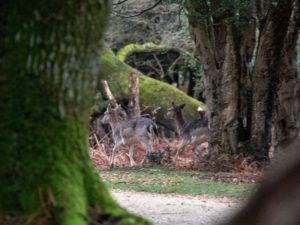by
Jeni Bell
28th January 2021

It is early on a late winter’s morning and the woods are wet. The chill and damp mix together to dress the leafless branches in a cape of fine mist. Few sounds filter through the silent hazels, just the rustles of a blackbird in leaf litter, and a Nuthatch tapping tree trunks above. But other than that, all is still. So the sudden snapping of twigs and velcro tear of bramble in the undergrowth is a surprise.
These woods are old, and I have to still my brain from conjuring ancient otherworldly entities from the tangle of branches.
As the sound starts to swirl like a gathering breeze, I spy the twig-snappers. They cross the path just ahead of me in a wave of colour: fawn, grey, startling white, and rich earthy brown.
Deer, but which ones?
There are a 3 main species throughout Cranborne Chase; these ones here are not the chestnut colour of roe, and they are far too big to be Muntjac. As they hurtle into the adjacent hazel, the bold black horseshoes on their rumps, alongside well-defined tail stripes, confirm to me their identity. Fallow.

The shelter of scrubby woodlands and the area’s open fields provide plentiful habitat for fallow to thrive.
Something they have done for years. It’s more than likely that today’s herds are descendants of escapees from the Chase’s once numerous deer parks; beacons of wealth and status, as well as a steady supply of venison for those deemed worthy.

Norma Chapman explains in her book, ‘Deer’, just why fallow were such a popular feature of these parks:
‘the fallow is considered by many to be the most pleasing of our deer, in appearance and taste!’
Bucks, with their impressive palmate (like open palms) antlers, and the dramatic colour variations found throughout the species, perhaps explain why they were so sought after. There are four main colour types:
- Common; all tan and fawn with white summer spots.
- White; not albinos, but white coated, often turning whiter with age.
- Menil; a paler version of the common, but the white spots stay present all year round.
- Melanistic; in which the coat appears black or chocolate brown.
It is not rare to see the colour variants here, and I’ve often seen white does. I have even encountered a midnight-coloured stag in the depths of the wood. Each meeting makes my heart race, and I appreciate the beauty they must have bestowed upon a deer park.
Of course, they were more than just ornamental. It is no secret that a love of hunting played a huge role in the history of the area. And the deer of the chase provided sport, as well as a winter supply of venison.

But with hunting comes poaching, and the books and accounts of Cranborne Chase tell tales of fierce rivalries between poaching gangs and keepers.
Ralph Whitlock, in his book ‘The Folklore of Wiltshire’ explains how in the middle ages
‘…generations of young bloods in south Wiltshire and north Dorset found sport in conducting poaching wars in Cranborne Chase. The game was to kill a deer without being caught by the keepers.’
Poachers revelled in the idea of being caught, in the hopes a fight ensued. These bloody battles left many injured, some dismembered or even dead.
King George II eventually introduced tighter penalties to establish some order, but not all poachers were looking for war, some were just after something for the pot. Whitlock recalls the Bowerchalke story of how one old lady, when unexpectedly visited by keepers, sat herself down on an old iron pot to hide the venison being cooked within it.
But, I like to think, that perhaps it was also the love of the encounter that drove people to seek them out. There is some unspeakable magic that happens when you come face to face with a fallow, or any deer for that matter. Time steadies itself, and you realise you’re not just watching any old beast, but an ancient one, with a far-reaching history.
The small fallow herd have vanished into the thicket and in the empty space carved by their absence, I feel the weight of that encounter even more so.

Looking after them, I think on how oblivious they are to the roles they’ve played here; entirely unaware that they were once depictions of wealth and prosperity.
Ignorant of the fact they were so sought-after people were compelled to commit crimes. And how these deer of Cranborne Chase, on their swift feet, unknowingly trail an entire history of a whole landscape and its people behind them.
Jeni Bell is a nature writer, particularly passionate about wildlife, walking and folklore, and based on the county lines of Wiltshire, Dorset and Hampshire. Drawing inspiration from the beauty of this special landscape her work explores our wild connection to the in between spaces and borderlands. You can read more of her work on her blog, Seeking Wild Sights.
